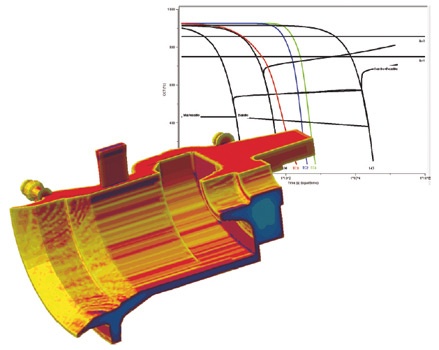Going Beyond Just Finding the Shrink
It is not just shrinkage that determines the final quality of a steel casting. Casting process simulation of steel castings also goes much further than just finding the shrink. In the case shown here, initially the gating and risering was developed for a drive tumbler that produced a high quality part, but the customer’s main interest was to figure out what could be achieved with an existing quench tank and minor alloying changes within the specs for the given alloy.
The heat treatment process involves the controlled heating of the component to homogenize the as-cast microstructure, rapid cooling to lock the alloying elements in place, and a re-heating of the casting during tempering to modify the as-quenched microstructure and obtain the required balance between toughness and strength.
Since heat treatment is all about controlling the temperature in the casting, experimental work was performed to develop heat transfer characteristics for the quench tank used. The experimental results were used together with MAGMASOFT® to inversely determine heat transfer coefficients using optimization and calculate the temperature distribution in the casting during heat treating.
By combining simulated local heating and cooling rates with a regression analysis generated from a database of Continuous Cooling Transformation (CCT) diagrams for hundreds of steel grades, the distribution of the martensite, bainite, ferrite and pearlite microstructures in the casting after quenching can be calculated. It is the combination of these microstructural components, and the changes they undergo during tempering, that determines the distribution of properties such as hardness, yield and tensile strength or elongation in the heat treated casting. Here, the optimized heat transfer data was used for multiple heat treatment simulations, providing insight into which hardness and elongation distributions could be expected with different alloying and different tempering processes. The predicted values were later found to be in good agreement with experimental values for actual parts and corresponding test blocks.
Characterizing the properties of cast steel component goes beyond solidification and shrink.


